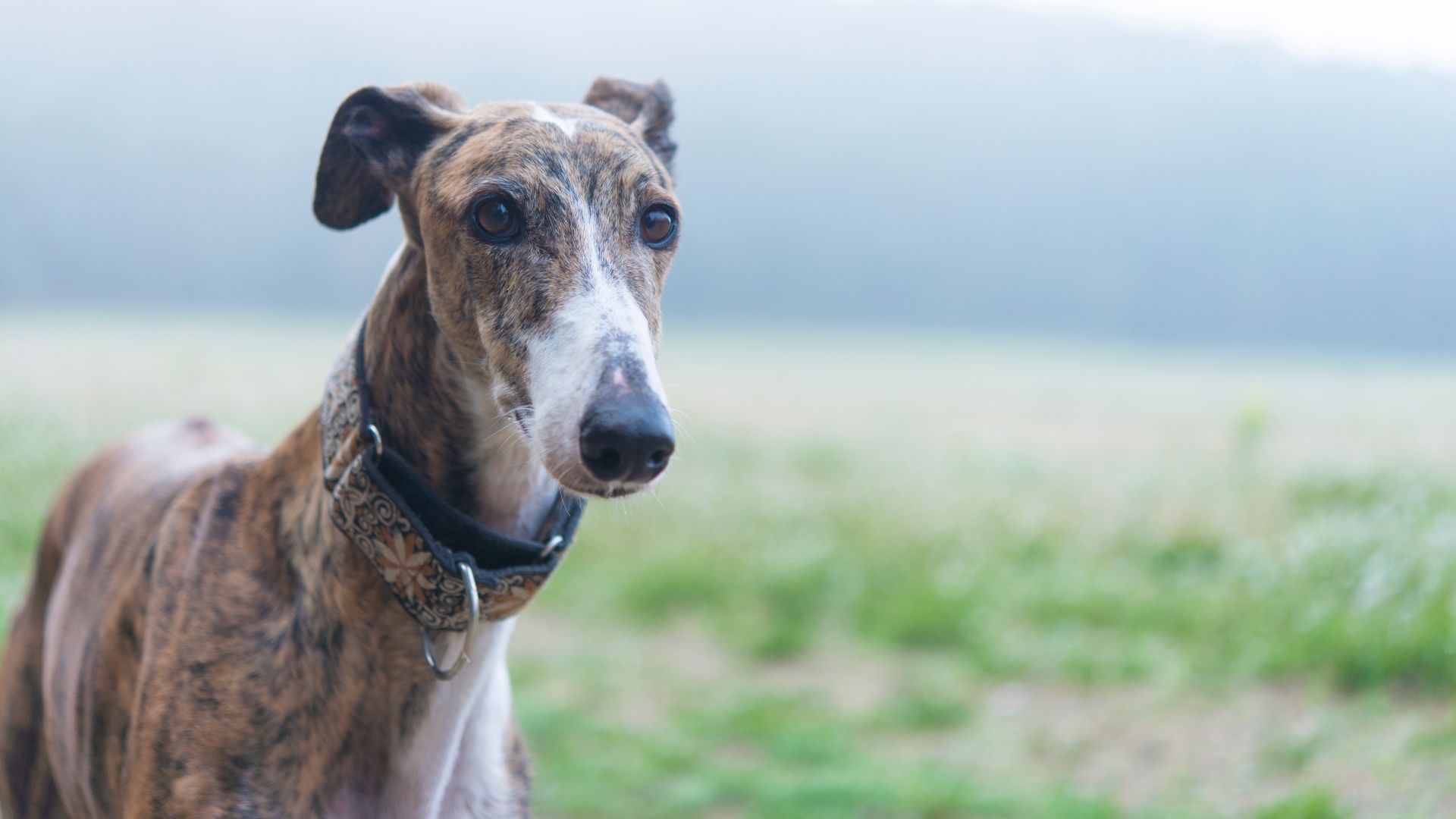Greyhound: Breed profile
Loyal and gentle companions, there's so much more to the Greyhound then their long-standing association with racing

Some people may not consider owning a Greyhound. As the fastest dogs in the world, they tend to be associated with Greyhound racing and so they are perhaps not always seen to be suitable pets. That, however, is simply untrue. Greyhounds have long been loyal, gentle companions beloved in homes across the world. Dating back around 4,000 years, which makes them one of the oldest dog breeds, they have also been a firm favorite of royals, celebrities and, of course, everyone's favorite animated family, The Simpsons.
Coming in a staggering 18 primary colors and 55 different color combinations, you're certainly going to be spoilt for choice if looks are important. That said, beneath the coat these sighthounds are generally the same, with their hallmark narrow faces, long-muscular reared bodies and long skinny legs. Most people take them in as puppies or adopt a Greyhound once their racing days are over. The latter is a great way to ensure these dogs are able to retire in comfort but there's no getting away from the fact that the races are controversial.
While this isn't the time and place to delve deeply into such matters, there are calls for the sport to be banned. Suffice to say, Greyhound racing's popularity does appear to be waning and there are fewer bets being placed today compared with a few years ago. Figures show it has gone from being the second most popular working class sport to one hallmarked by closing stadia. But let's take a look at the dogs themselves and why you should consider one.
How much exercise does a Greyhound need?
Life expectancy: 10-14 years
Average weight: Male: 88lbs/40kg Female: 75lbs/34kg
About the same as: A wooden bookcase
You may think a Greyhound is always on the go, darting around at up to 45 miles-per-hour (72 km/h) just like they do when they're asked to race around a track. Yet that couldn't be further from the truth. They're actually more than happy just curling up on the couch and those bursts of speed are just that – bursts. A Greyhound simply doesn't have the stamina or energy to keep that up for hours on end but you do have to get them moving.
When they're not kipping (and they'll do so for up to 18 hours a day), you should be taking them out – on a leash – for about an hour daily. Doing so not only burns off the abundance of energy they'll be conserving, it also keeps their mind ticking over, preventing them from becoming bored and potentially destructive.
As you do so, keep a close eye on them in case they're showing signs of fatigue and if you find a secure place for them to run (away from small animals!), then let them loose for a good sprint. Similarly, ensure your own yard is secure because Greyhounds have a strong prey drive and they'll soon decide to give chase: you'll have little luck keeping up with them once their mind is fixated in this way.
Are Greyhounds easy to train?
Suitable for: Anyone who wants a low-maintenance breed
Not suitable for: People who live in areas with lots of small animals
Temperament: Intelligent, affectionate, sleepy
Shedding: Moderate
As with all dogs, training should begin the moment a Greyhound steps foot inside your home and, as long as you use positive reinforcement and refrain from bellowing at this most sensitive of breeds, you should find they become receptive and respectful towards you.
Get the best advice, tips and top tech for your beloved Pets
That said, you do need to be patient and consistent. Like other hound breeds, Greyhounds are a stubborn and independent, and you may find that you need to give them lots of encouragement. You will also have to work on their inherent shyness and get them socialized with other dogs as soon as you can – more so if you've taken one in as a puppy.
Thankfully, if you're training a retired Greyhound, then they're already going to be comfortable around people. What you will likely have to work on in this circumstance, though, is their puppy-like tendency to chew and small things such as getting them to negotiate stairs. Training an adopted Greyhound is about understanding that they will likely have a particular state of mind from their working days. By making training fun while reducing the risk of them getting into trouble, you'll be better able to engage this breed.
One of the problems you'll almost certainly discover regardless of their stage in life is a Greyhound's seeming inability to understand what you mean by “sit”. They're not actually being deliberately awkward though. They find popping their bottom on the floor a tad uncomfortable. You should also avoid being repetitive in your training or else you run the risk of losing their concentration.
Are Greyhounds good with kids?

Yes, this breed can be one of the best breeds for families. Greyhounds have a lovely temperament and they'll be gentle, patient and caring around children. They will almost tip-toe near very small kids so as not to cause harm and they'll generally react to over-curious pokes and prods by walking away.
Of course, there is always a risk that a dog the size of a Greyhound could bump into a child and cause an injury and you should never leave a kid alone with a dog. But Greyhounds are adaptable, learn fast and become tolerant very quickly. Even so, you should consider how a child behaves towards them and educate them to be respectful. A Greyhound can become easily hurt because they have very thin skin that doesn't take much to tear.
What do Greyhounds eat?
One thing's for sure, Greyhounds love to eat and they adore treats. But given they will sleep for much of the day, you do need to be careful not to overfeed them. They have a tendency to put on weight and that causes serious damage to their health.
Aim to give them the best dry dog food containing no more than 20 percent protein and don't go overboard on the portions. For males, up to four cups each day spread over two meals will be sufficient and up to three cups for females is enough.
Do Greyhounds bark a lot?
No. Greyhounds are one of the quieter dog breeds, by and large. That's not to say they won't bark but, if they do, then you can rest assured that it's generally a sign that they are happy. For starters, they'll only tend to make a noise after they feel settled in your home. They will also bark when they are playing. Just be aware of not being overly fussy if a Greyhound barks – they'll end up realizing that it's a good way to get your attention.
Are Greyhounds aggressive?
Greyhounds are not overly known for being aggressive towards humans but woe betide they come across a small animal. A Greyhound's high prey drive means they'll relentlessly chase after animals, whether that's a squirrel popping into the yard to say a swift hello (and even quicker goodbye) or the next-door neighbor's cat. It's why you need to keep them in a secure area and on a leash when you're taking them for walks, especially because they have been known to kill small pets.
If they do show aggression towards humans, then it will tend to be out of fear. In those cases, it's a good idea to address what is causing the problem to prevent further stress. You'll also likely find that adopted racing greyhounds can be more aggressive than those taken in as puppies, depending on their background. Before adopting, ask lots of questions and assess whether the dog has experience of living in a family home.
Do Greyhounds shed a lot?
Amount of shedding: Moderate
Easy to groom: Yes
General health: Good
Potential for weight gain: High
Greyhounds have short coats but they do shed, more so during the Spring and Fall. But they are easy to groom – running a soft bristle brush over their coat a few times a week should do the trick and you only need to bathe them every three months or so. Just remember to look after their nails, teeth and ears and watch out for signs of infection. Indeed, Greyhounds are among the best low maintenance dog breeds, so you won't need to worry too much about keeping them in tip-top shape.
Wisdom Panel Breed Discovery DNA Kit | Amazon
Not sure exactly what breed your dog is? This kit screens for 365+ breeds – because knowing every detail about your dog helps you understand how best to care for them.
Greyhound health problems
Greyhounds are generally healthy dogs. Common problems include periodontal disease, Von Willebrand's disease caused by a deficiency in blood platelet function, obesity and bloat, the latter requiring urgent surgery because it can cause death if it's not treated. A good quality diet, exercise and supervision will help to head off many problems. It's always a good idea to have the best pet insurance on hand for peace of mind.
Should I get a Greyhound?
Yes. If you're after a gentle, loving, low maintenance dog that will fit in well with your family, you can't really go too far wrong with a Greyhound. In fact, they are one of the best dogs for seniors despite their large size. They're not quite as appealing for active people, though. While they will engage in intense exercise, they'd much rather snooze. It's quite ironic that such a speedy animal is actually a couch potato at heart but it's rather endearing all the same.
Want to learn more about this breed? Here are our favorite greyhound facts

David Crookes has been a journalist for almost 30 years and he has written for a host of magazines, newspapers, websites and books including the World of Animals Annual, BBC Earth, Live Science, The Independent and Tom’s Guide.
Born in England, he lives with two cats but he’s also keenly interested in the differences between the huge number of dog breeds – in fact, you can read many of his breed guides that he’s written in collaboration with vets here on PetsRadar.
With a lifelong passion for technology, too, he’s always on the lookout for useful devices that will allow people to keep their pets happier and healthier, and provide them more time to spend together.
David has a degree from Durham University, as well as postgraduate diploma in journalism from the University of Central Lancashire.

